Insurance Assignment: Characteristics, Plans, Payers, and Risks
VerifiedAdded on 2022/09/29
|5
|1151
|19
Homework Assignment
AI Summary
This assignment explores the fundamental characteristics of insurance, addressing key concepts such as pooling of losses, payment for random losses, risk transfer, and indemnification. It delves into adverse selection and moral hazard, explaining how insurance companies manage these challenges. The assignment also examines third-party payers in health insurance, including government entities, insurance companies, employers, and HMOs. Furthermore, it provides a detailed overview of managed care plans, highlighting their characteristics and different types, such as Health Maintenance Organizations (HMOs), Preferred Provider Organizations (PPOs), and high-deductible plans. The content is well-structured, providing clear definitions and examples to enhance understanding of the insurance domain.
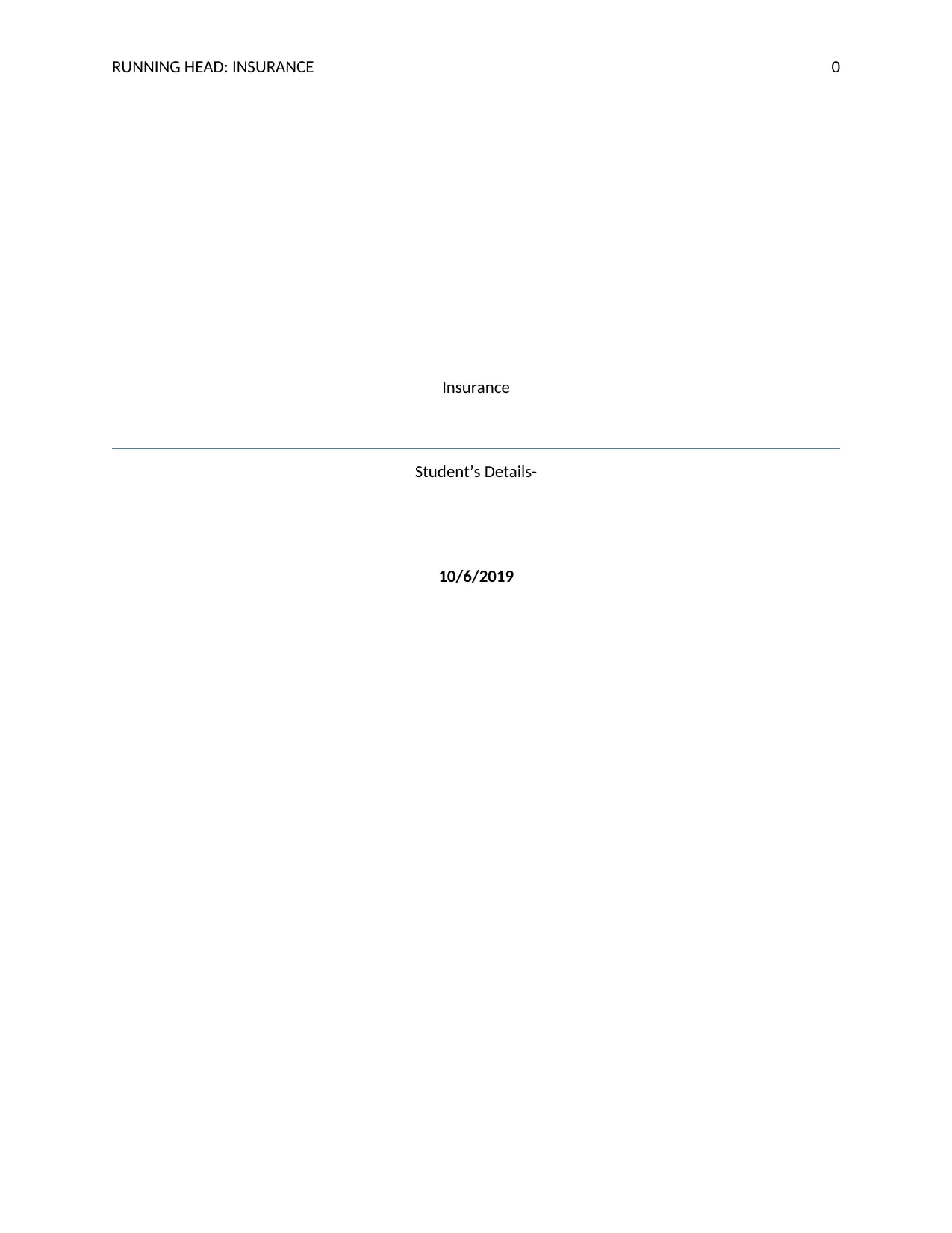
RUNNING HEAD: INSURANCE 0
Insurance
Student’s Details-
10/6/2019
Insurance
Student’s Details-
10/6/2019
Paraphrase This Document
Need a fresh take? Get an instant paraphrase of this document with our AI Paraphraser
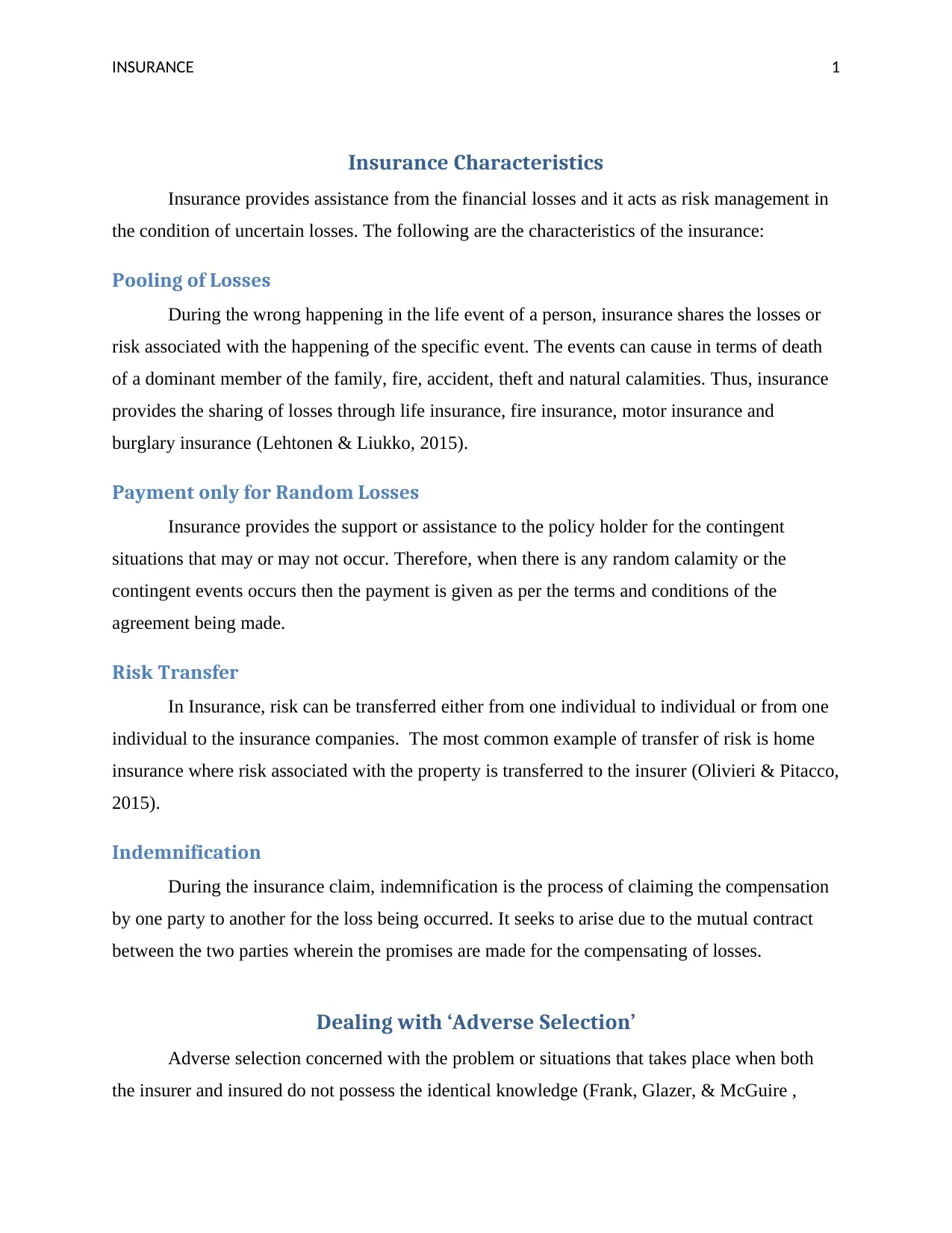
INSURANCE 1
Insurance Characteristics
Insurance provides assistance from the financial losses and it acts as risk management in
the condition of uncertain losses. The following are the characteristics of the insurance:
Pooling of Losses
During the wrong happening in the life event of a person, insurance shares the losses or
risk associated with the happening of the specific event. The events can cause in terms of death
of a dominant member of the family, fire, accident, theft and natural calamities. Thus, insurance
provides the sharing of losses through life insurance, fire insurance, motor insurance and
burglary insurance (Lehtonen & Liukko, 2015).
Payment only for Random Losses
Insurance provides the support or assistance to the policy holder for the contingent
situations that may or may not occur. Therefore, when there is any random calamity or the
contingent events occurs then the payment is given as per the terms and conditions of the
agreement being made.
Risk Transfer
In Insurance, risk can be transferred either from one individual to individual or from one
individual to the insurance companies. The most common example of transfer of risk is home
insurance where risk associated with the property is transferred to the insurer (Olivieri & Pitacco,
2015).
Indemnification
During the insurance claim, indemnification is the process of claiming the compensation
by one party to another for the loss being occurred. It seeks to arise due to the mutual contract
between the two parties wherein the promises are made for the compensating of losses.
Dealing with ‘Adverse Selection’
Adverse selection concerned with the problem or situations that takes place when both
the insurer and insured do not possess the identical knowledge (Frank, Glazer, & McGuire ,
Insurance Characteristics
Insurance provides assistance from the financial losses and it acts as risk management in
the condition of uncertain losses. The following are the characteristics of the insurance:
Pooling of Losses
During the wrong happening in the life event of a person, insurance shares the losses or
risk associated with the happening of the specific event. The events can cause in terms of death
of a dominant member of the family, fire, accident, theft and natural calamities. Thus, insurance
provides the sharing of losses through life insurance, fire insurance, motor insurance and
burglary insurance (Lehtonen & Liukko, 2015).
Payment only for Random Losses
Insurance provides the support or assistance to the policy holder for the contingent
situations that may or may not occur. Therefore, when there is any random calamity or the
contingent events occurs then the payment is given as per the terms and conditions of the
agreement being made.
Risk Transfer
In Insurance, risk can be transferred either from one individual to individual or from one
individual to the insurance companies. The most common example of transfer of risk is home
insurance where risk associated with the property is transferred to the insurer (Olivieri & Pitacco,
2015).
Indemnification
During the insurance claim, indemnification is the process of claiming the compensation
by one party to another for the loss being occurred. It seeks to arise due to the mutual contract
between the two parties wherein the promises are made for the compensating of losses.
Dealing with ‘Adverse Selection’
Adverse selection concerned with the problem or situations that takes place when both
the insurer and insured do not possess the identical knowledge (Frank, Glazer, & McGuire ,
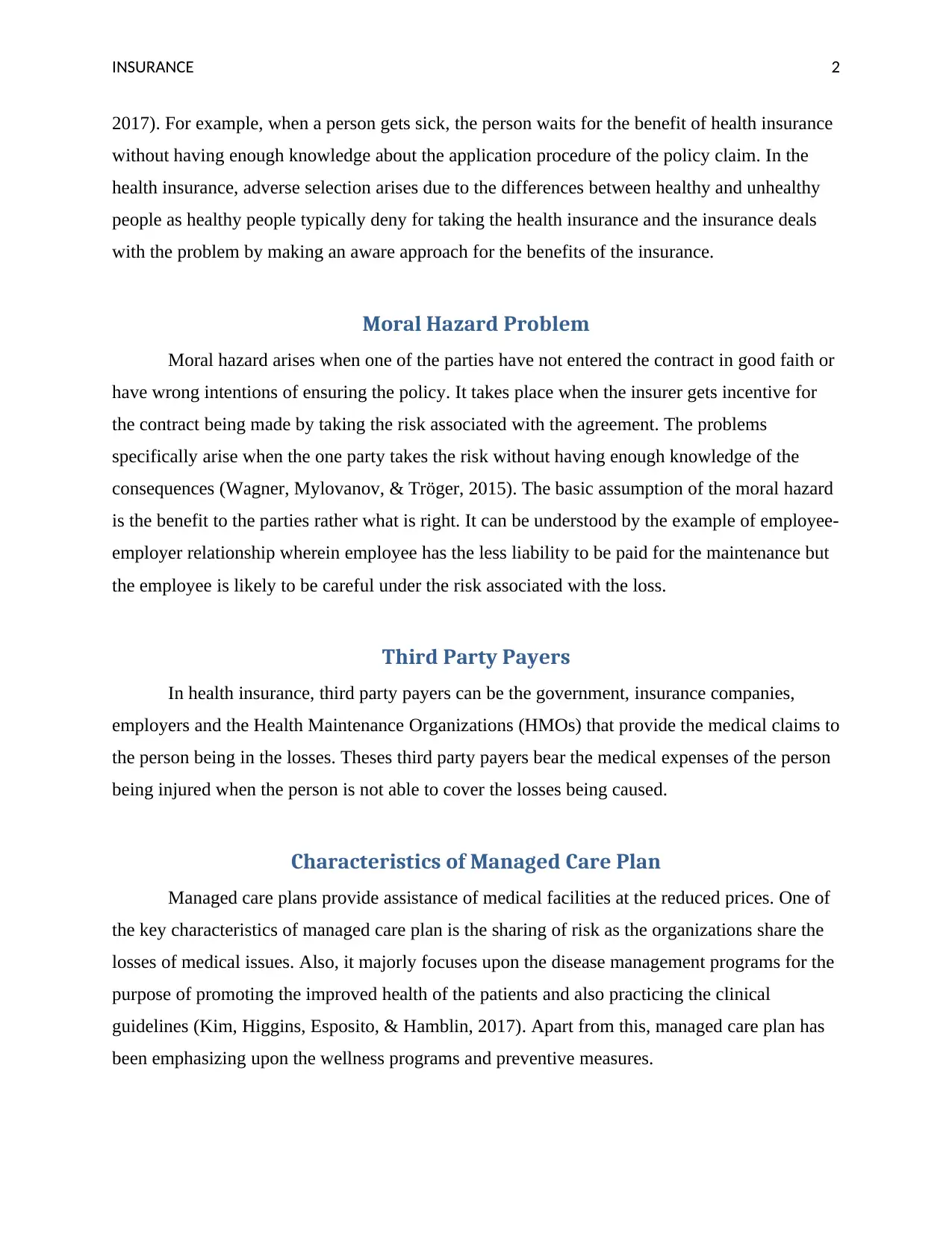
INSURANCE 2
2017). For example, when a person gets sick, the person waits for the benefit of health insurance
without having enough knowledge about the application procedure of the policy claim. In the
health insurance, adverse selection arises due to the differences between healthy and unhealthy
people as healthy people typically deny for taking the health insurance and the insurance deals
with the problem by making an aware approach for the benefits of the insurance.
Moral Hazard Problem
Moral hazard arises when one of the parties have not entered the contract in good faith or
have wrong intentions of ensuring the policy. It takes place when the insurer gets incentive for
the contract being made by taking the risk associated with the agreement. The problems
specifically arise when the one party takes the risk without having enough knowledge of the
consequences (Wagner, Mylovanov, & Tröger, 2015). The basic assumption of the moral hazard
is the benefit to the parties rather what is right. It can be understood by the example of employee-
employer relationship wherein employee has the less liability to be paid for the maintenance but
the employee is likely to be careful under the risk associated with the loss.
Third Party Payers
In health insurance, third party payers can be the government, insurance companies,
employers and the Health Maintenance Organizations (HMOs) that provide the medical claims to
the person being in the losses. Theses third party payers bear the medical expenses of the person
being injured when the person is not able to cover the losses being caused.
Characteristics of Managed Care Plan
Managed care plans provide assistance of medical facilities at the reduced prices. One of
the key characteristics of managed care plan is the sharing of risk as the organizations share the
losses of medical issues. Also, it majorly focuses upon the disease management programs for the
purpose of promoting the improved health of the patients and also practicing the clinical
guidelines (Kim, Higgins, Esposito, & Hamblin, 2017). Apart from this, managed care plan has
been emphasizing upon the wellness programs and preventive measures.
2017). For example, when a person gets sick, the person waits for the benefit of health insurance
without having enough knowledge about the application procedure of the policy claim. In the
health insurance, adverse selection arises due to the differences between healthy and unhealthy
people as healthy people typically deny for taking the health insurance and the insurance deals
with the problem by making an aware approach for the benefits of the insurance.
Moral Hazard Problem
Moral hazard arises when one of the parties have not entered the contract in good faith or
have wrong intentions of ensuring the policy. It takes place when the insurer gets incentive for
the contract being made by taking the risk associated with the agreement. The problems
specifically arise when the one party takes the risk without having enough knowledge of the
consequences (Wagner, Mylovanov, & Tröger, 2015). The basic assumption of the moral hazard
is the benefit to the parties rather what is right. It can be understood by the example of employee-
employer relationship wherein employee has the less liability to be paid for the maintenance but
the employee is likely to be careful under the risk associated with the loss.
Third Party Payers
In health insurance, third party payers can be the government, insurance companies,
employers and the Health Maintenance Organizations (HMOs) that provide the medical claims to
the person being in the losses. Theses third party payers bear the medical expenses of the person
being injured when the person is not able to cover the losses being caused.
Characteristics of Managed Care Plan
Managed care plans provide assistance of medical facilities at the reduced prices. One of
the key characteristics of managed care plan is the sharing of risk as the organizations share the
losses of medical issues. Also, it majorly focuses upon the disease management programs for the
purpose of promoting the improved health of the patients and also practicing the clinical
guidelines (Kim, Higgins, Esposito, & Hamblin, 2017). Apart from this, managed care plan has
been emphasizing upon the wellness programs and preventive measures.
⊘ This is a preview!⊘
Do you want full access?
Subscribe today to unlock all pages.

Trusted by 1+ million students worldwide
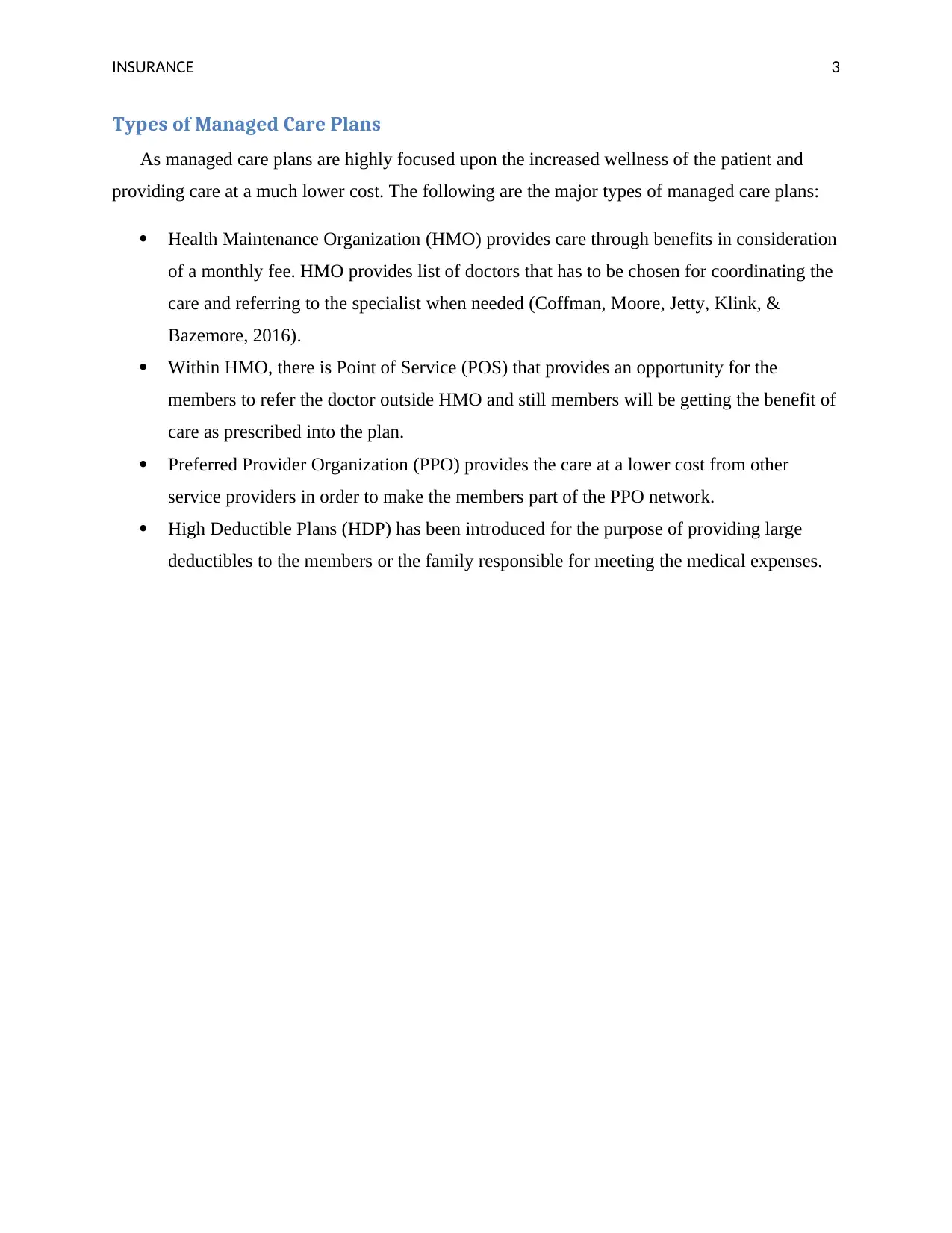
INSURANCE 3
Types of Managed Care Plans
As managed care plans are highly focused upon the increased wellness of the patient and
providing care at a much lower cost. The following are the major types of managed care plans:
Health Maintenance Organization (HMO) provides care through benefits in consideration
of a monthly fee. HMO provides list of doctors that has to be chosen for coordinating the
care and referring to the specialist when needed (Coffman, Moore, Jetty, Klink, &
Bazemore, 2016).
Within HMO, there is Point of Service (POS) that provides an opportunity for the
members to refer the doctor outside HMO and still members will be getting the benefit of
care as prescribed into the plan.
Preferred Provider Organization (PPO) provides the care at a lower cost from other
service providers in order to make the members part of the PPO network.
High Deductible Plans (HDP) has been introduced for the purpose of providing large
deductibles to the members or the family responsible for meeting the medical expenses.
Types of Managed Care Plans
As managed care plans are highly focused upon the increased wellness of the patient and
providing care at a much lower cost. The following are the major types of managed care plans:
Health Maintenance Organization (HMO) provides care through benefits in consideration
of a monthly fee. HMO provides list of doctors that has to be chosen for coordinating the
care and referring to the specialist when needed (Coffman, Moore, Jetty, Klink, &
Bazemore, 2016).
Within HMO, there is Point of Service (POS) that provides an opportunity for the
members to refer the doctor outside HMO and still members will be getting the benefit of
care as prescribed into the plan.
Preferred Provider Organization (PPO) provides the care at a lower cost from other
service providers in order to make the members part of the PPO network.
High Deductible Plans (HDP) has been introduced for the purpose of providing large
deductibles to the members or the family responsible for meeting the medical expenses.
Paraphrase This Document
Need a fresh take? Get an instant paraphrase of this document with our AI Paraphraser
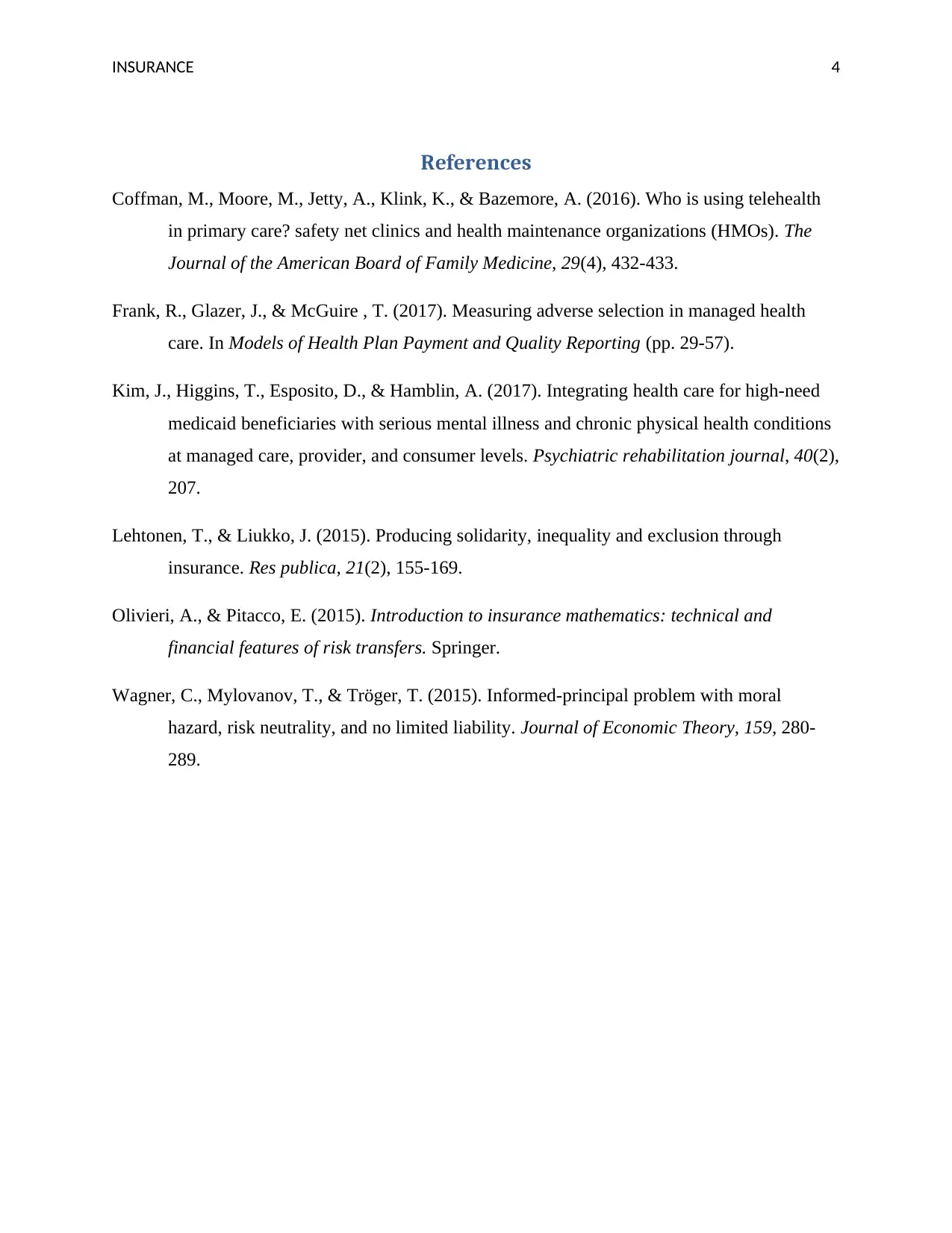
INSURANCE 4
References
Coffman, M., Moore, M., Jetty, A., Klink, K., & Bazemore, A. (2016). Who is using telehealth
in primary care? safety net clinics and health maintenance organizations (HMOs). The
Journal of the American Board of Family Medicine, 29(4), 432-433.
Frank, R., Glazer, J., & McGuire , T. (2017). Measuring adverse selection in managed health
care. In Models of Health Plan Payment and Quality Reporting (pp. 29-57).
Kim, J., Higgins, T., Esposito, D., & Hamblin, A. (2017). Integrating health care for high-need
medicaid beneficiaries with serious mental illness and chronic physical health conditions
at managed care, provider, and consumer levels. Psychiatric rehabilitation journal, 40(2),
207.
Lehtonen, T., & Liukko, J. (2015). Producing solidarity, inequality and exclusion through
insurance. Res publica, 21(2), 155-169.
Olivieri, A., & Pitacco, E. (2015). Introduction to insurance mathematics: technical and
financial features of risk transfers. Springer.
Wagner, C., Mylovanov, T., & Tröger, T. (2015). Informed-principal problem with moral
hazard, risk neutrality, and no limited liability. Journal of Economic Theory, 159, 280-
289.
References
Coffman, M., Moore, M., Jetty, A., Klink, K., & Bazemore, A. (2016). Who is using telehealth
in primary care? safety net clinics and health maintenance organizations (HMOs). The
Journal of the American Board of Family Medicine, 29(4), 432-433.
Frank, R., Glazer, J., & McGuire , T. (2017). Measuring adverse selection in managed health
care. In Models of Health Plan Payment and Quality Reporting (pp. 29-57).
Kim, J., Higgins, T., Esposito, D., & Hamblin, A. (2017). Integrating health care for high-need
medicaid beneficiaries with serious mental illness and chronic physical health conditions
at managed care, provider, and consumer levels. Psychiatric rehabilitation journal, 40(2),
207.
Lehtonen, T., & Liukko, J. (2015). Producing solidarity, inequality and exclusion through
insurance. Res publica, 21(2), 155-169.
Olivieri, A., & Pitacco, E. (2015). Introduction to insurance mathematics: technical and
financial features of risk transfers. Springer.
Wagner, C., Mylovanov, T., & Tröger, T. (2015). Informed-principal problem with moral
hazard, risk neutrality, and no limited liability. Journal of Economic Theory, 159, 280-
289.
1 out of 5
Related Documents
Your All-in-One AI-Powered Toolkit for Academic Success.
+13062052269
info@desklib.com
Available 24*7 on WhatsApp / Email
![[object Object]](/_next/static/media/star-bottom.7253800d.svg)
Unlock your academic potential
Copyright © 2020–2025 A2Z Services. All Rights Reserved. Developed and managed by ZUCOL.





